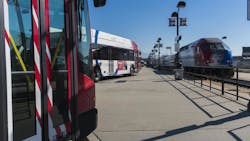APTA: Public Transit Modes Made 9.9 Billion Trips in 2018
A report released by the American Public Transportation Association (APTA) says Americans took 9.9 billion trips on public transportation in 2018. The overall ridership is down 2 percent compared to ridership in 2017, but commuter rail increased by 0.4 percent in 2018, as did demand response ridership, which increased by 2.1 percent.
Taking a macro perspective to ridership trends, APTA reports that ridership has grown 27 percent between 1995 and 2018, surpassing the U.S. population, which grew at 23 percent. APTA also notes passenger miles traveled on public transportation grew by 39 percent, which is more than the 33 percent growth of vehicle miles traveled on the roads.
“Public transportation continues to offer great value to a community and its residents as it provides access to jobs, health care, schools and local businesses,” said APTA President and CEO Paul P. Skoutelas. “As people have more transportation options than ever before, public transportation systems around the country are experimenting with new programs and services to attract new riders.”
Highlights from APTA's national ridership breakdown include:
- Commuter rail ridership increased overall by 0.41 percent and 18 out of 31 systems saw ridership increases.
- Light rail, which includes modern streetcars, trolleys and heritage trolleys, saw overall ridership decrease by 3 percent, but nine out of 28 systems saw ridership growth.
- Heavy rail, which includes subways and elevated trains, decreased overall by 2.6 percent, but cities such as San Juan, Puerto Rico and Philadelphia, Penn., both saw ridership increase on their heavy rail systems.
- Bus ridership decreased nationally by 1.8 percent, but Pittsburgh, Penn., Columbus, Ohio and Las Vegas posted ridership increases between two and three percent.
- Demand response (paratransit) ridership increased in 2018 by 2.1 percent.
APTA issued a policy report in April 2018, "Understanding Recent Ridership Changes: Trends and Adaptations," that analyzed the changing transportation ecosystem and its impact on public transportation. It identified four categories of factors: erosion of time competitiveness, erosion of cost competitiveness, reduced customer affinity and loyalty and external factors beyond the control of a public transportation system.
Despite year-over-year decreases, APTA's current ridership report includes plenty of examples where ridership saw increases in both small and large communities. For example, Metro Transit in Minneapolis, Minn., saw ridership records in 2018 on its light-rail lines and the Bus Rapid Transit (BRT) line. APTA says that reasons for these record ridership increases include the attractiveness of fast, frequent and reliable service; the result of continued transit oriented development along these transitways; several large events, including the Super Bowl; and significant road construction on one of the region’s busiest highways which has led some travelers to take light-rail service.
The Central Ohio Transit Authority (Columbus, OH) saw a 3 percent increase in ridership in 2018, providing nearly 19 million trips. APTA credits the launch of COTA's first Bus Rapid Transit line, CMAX, which puts customers closer to 200,000 jobs, two hospitals and three post-secondary campuses. CMAX had a 17.5 percent increase over fixed-route ridership covering the same area in the year prior. COTA also launched C-pass, an employer-funded pass program that provides transit to downtown Columbus workers at no cost to them.
BRT also plays a role in the 4.7 percent ridership increase seen in the Utah Transit Authority’s commuter rail system, FrontRunner. This large increase is due in large part to the inception of a new high-frequency BRT route called UVX that takes riders to two FrontRunner stations. Launched in August, UVX was rapidly adopted by riders and by the end of 2018 average weekday ridership on UVX was almost five times the ridership on the previous routes that served the alignment.
About the Author

Mischa Wanek-Libman
Group Editorial Director
Mischa Wanek-Libman is director of communications with Transdev North America. She has more than 20 years of experience working in the transportation industry covering construction projects, engineering challenges, transit and rail operations and best practices.
Wanek-Libman has held top editorial positions at freight rail and public transportation business-to-business publications including as editor-in-chief and editorial director of Mass Transit from 2018-2024. She has been recognized for editorial excellence through her individual work, as well as for collaborative content.
She is an active member of the American Public Transportation Association's Marketing and Communications Committee and served 14 years as a Board Observer on the National Railroad Construction and Maintenance Association (NRC) Board of Directors.
She is a graduate of Drake University in Des Moines, Iowa, where she earned a Bachelor of Arts degree in Journalism and Mass Communication.
